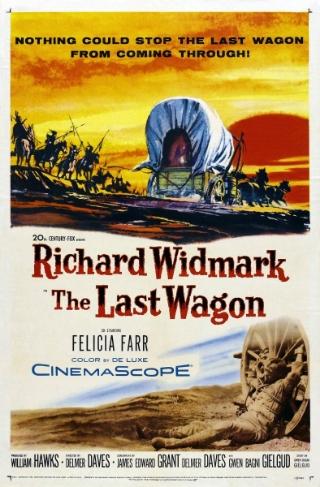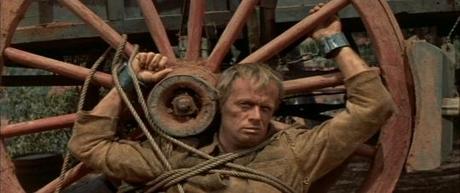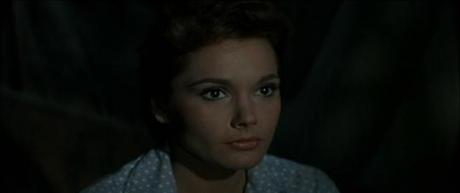
There she lies…as far into the west as your eyes can see, and then some – The Canyon of Death. The Indians say you can hear cries in the night down there that you’ll hear all your life…usually it’s only the wind.
The more I watch Delmer Daves’ westerns, the higher they rise in my estimation. As a body of work, they work on so many levels and manage to weave a variety of themes into their plots. In terms of basic structure, The Last Wagon (1956) has a simple and straightforward plot – a tough outsider uses his knowledge of the frontier to lead a group of greenhorns to safety. Yet within this fairly standard framework, there are a number of interesting elements vying for the viewer’s attention. The film can be enjoyed as a kind of outdoor survivalist epic; however, it’s also a critique of race and prejudice, a celebration of the positive influence of women, a revenge tale, and ultimately a journey towards redemption. Above all though, and this is the case with most of Daves’ pictures, there is an overriding sense of optimism that pervades the movie. In short, and characteristic of the best westerns of the 50s, it’s an affirmation of the essentially positive aspects of human nature, making it a very American film.
It’s Arizona in 1873, and a rider makes his way down towards a river. The camera pulls back to reveal another figure, a rifleman clad in buckskins concealed on the near bank. He calmly takes aim and drops the rider before wading across to confirm his kill. This dramatic pre-credits sequence introduces Comanche Todd (Richard Widmark) in ambiguous terms – is this silent, ruthless killer the hunter or the hunted? It’s soon established that he falls into the latter category, a fugitive being pursued by a relentless posse. Still, Todd is no hapless or helpless victim – he’s an accomplished survivor, having been raised by and lived among the Comanche for twenty years. Nevertheless, he’s not some invulnerable superhuman either, and soon finds himself the bound captive of a brutal sheriff (George Mathews), the last of the posse members. Now all this is just a build-up to the main events of the story, which kick in when the two men cross paths with a wagon train of settlers. In one of the most memorable images from the movie, Todd finds himself shackled to the spokes of a wagon wheel as the settlers reluctantly agree to allow the sheriff and his prisoner to accompany them. Todd’s presence stirs a mixed reaction; the hero-worship of a young boy (Tommy Rettig), a vague attraction in the kid’s elder sister and guardian (Felicia Farr), and bitter resentment among two half sisters – one of whom is part Indian (Susan Kohner) and the other (Stephanie Griffin) a spoiled and overt racist. All of these elements are explored and probed more deeply after disaster befalls the camp. While the young people sneak off for a midnight swim, an Apache raiding party descends on the settlers and kills everyone. Everyone except Todd, whose wagon they roll over a cliff with him still attached. Miraculously, the plunge doesn’t kill him and leaves him in a position to take charge of the frightened and confused group of young people. It’s now down to this wanted killer to lead his raw companions through the Canyon of Death, and on to safety. Aside from the ever-present danger, Todd’s progress is made more difficult by the suspicion of the group and their internal wrangling. What’s more, every step closer to salvation for the youngsters brings Todd nearer a date with the hangman.

As I said back at the beginning, one of the notable features of much of Delmer Daves’ work is its optimism. I’ve mentioned before a tendency in Daves’ films towards endings that can appear weak in relation to what has preceded. However, as a result of some discussions we’ve had on this site, I’ve been reassessing this position. If Daves’ films are viewed as pieces whose aim is to project a positive take on humanity, then the relatively upbeat endings make a lot more sense and actually fit the narrative thrust better. Additionally, and I’m referring particularly to the westerns here, Daves’ best films are all from the 50s, and this progression towards a positive resolution for his anti-heroic protagonists mirrors the general trend in the genre during that decade. In The Last Wagon, Todd starts out as a man driven on by his thirst for revenge against those who destroyed his family. Although he’s never fully drawn back to white society, he is offered a new perspective on life. It’s the combination of a boy’s devotion and loyalty, and the burgeoning love of a girl that maps out a more hopeful future for him. It’s only through his acknowledgment of these two factors that Todd is able to seek out and achieve the personal redemption that gives meaning to the story. From a purely technical point of view, Daves’ work on The Last Wagon is as good as anything he did. The director, along with cameraman Wilfrid Cline, shot the film almost exclusively on location in Arizona, and the use of landscape is spectacular at times. There are many instances of wide, long shots looking down on and across the vast expanses dotted with canyons and buttes. These shots emphasize both the freedom of the country, and also the isolation and relative insignificance of the characters. It all makes for a wonderful contrast with the tight, intimate feeling conveyed by the scenes showing the group interacting whenever they stop to make camp.

As far as performances are concerned, the film really belongs to both Widmark and Felicia Farr. What is most remarkable about Widmark’s playing in The Last Wagon is his physicality. For an actor whose distinctive voice and looks are such a large part of his repertoire, Widmark made less use of them here than in his other movies. Instead, it’s his cat-like grace and spatial awareness that are to the fore. One would expect a man who has lived his adult life in harmony with the wilderness to appear comfortable and almost at one with his natural surroundings. Such is the case with Widmark as he pads round soundlessly and deftly skips across the rocks and sand. Widmark brought a genuine physical confidence to this role, and his fight scenes – especially his duel, using knife and manacle, with two Apache warriors – have a ring of authenticity to them. On top of that, there’s a raw frankness that Widmark achieves in his scenes together with Felicia Farr. The actress made three films for Delmer Daves, and the quality of the work she did makes me regret they hadn’t collaborated more. In westerns, femininity is seen as a civilizing force, balancing masculine individualism and aggression, and Daves was very good at highlighting this vital aspect. As in her other two films for the director, Farr plays a pivotal role in drawing out the hero and humanizing him. Daves seemed to have a knack for tapping into Farr’s strengths and mining her attractive vulnerability. Just like in Jubal and 3:10 to Yuma, Farr’s intimate scenes with the hero are poignant and beautifully memorable.
While the central character of Comanche Todd, and his deep respect for native ways, plays a large part in getting the anti-racist message of the movie across, it’s by no means the only one. Perhaps equally important are the roles of Susan Kohner and Stephanie Griffin. The latter’s open hostility towards her half-sister, based purely on her disdain for her Indian blood, exposes the ugliness that is only disguised by her superficial beauty. Again, the redemptive nature of the western story is emphasized through the gradual transformation of this hate fueled character into a more human and understanding figure by the end. In contrast to Griffin’s naked bigotry, Kohner is the very epitome of dignity and self-deprecation. If Griffin’s character develops in an interesting way, then Kohner’s goes on an equally fascinating journey. It’s through her character, more so even than Widmark’s, that the whole question of identity is addressed. The point being made in the movie is the importance of pride in oneself, and the crucial fact that one can be proud without allowing apparently conflicting social identities to displace each other.
The Last Wagon has been widely available on DVD in most territories for some time now. I have the US release from Fox, and it features a fine anamorphic scope transfer. The disc is one of those odd, from my perspective at least, ones which has the widescreen version on one side and a pan & scan copy on the other. Personally, I see 4:3 versions of scope movies as redundant and can’t really understand the need to include them. Extra features amount to a series of galleries and a selection of trailers for other Fox westerns. The movie comes from Delmer Daves’ strongest period, when he could hardly put a foot wrong, and has to rate among his best work. Like all the best films, The Last Wagon works fine if viewed simply as a piece of entertainment. However, its real strength is the way, as all great westerns do, it turns the focus on other issues and themes, and so encourages the viewer to think. The fact that both Jubal and 3:10 to Yuma are about to get released on Blu-ray by Criterion brought this film back to my attention - I’d love to think those releases might lead to a critical and popular reappraisal of the strengths of Delmer Daves in particular and the western in general.
